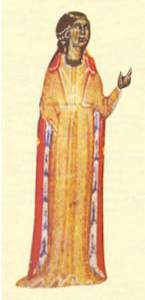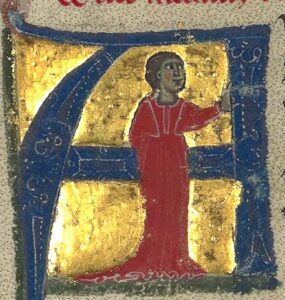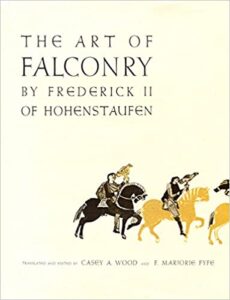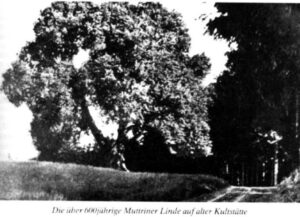The act of performing with an instrument or on a stage provides a space within which to give voice to thoughts and emotions that might otherwise not be expressed. Many famous actors are shy in real life. Trobairitz, the female counterpart of the troubadours of the 12th and 13th century, may have been familiar with this experience of being liberated through the medium of their performance.
Who were the trobairitz?
In the early 12th century, the troubadour school or tradition originated in a region of southern France as well as parts of Italy and Spain known as Occitania. Occitan was a Romance language; the closest linguistic relative is Catalan. Related musical traditions developed in Germany, Galicia, Portugal, and northern France. The art of the troubadours declined and eventually died out by the middle of the 13th century. Trobairitz came from that same tradition.
Unlike some of the troubadours, trobairitz were born into the nobility. Their careers presumably started with the basic education provided to noblewomen, all of whom were expected to be able to sing, play instruments, and dance. Over time, they began to establish themselves as composers in their own right, writing works about courtly love, a popular theme in medieval Europe.
Trobairitz are not to be confused with joglaresas. Joglars and joglaresas, also known as minstrels, came from lower social strata of society while troubadours and trobairitz with a few exceptions were part of courtly society. Joglars were performers who did not usually compose. They sang, played instruments, danced, and even did acrobatics. While some joglars and joglaresas were retained by royalty and high society, many wandered from location to location, even performing in the streets.
The existence of the trobairitz is all the more surprising and fascinating when one considers the context as it pertained to women in the 12th century. Other than embracing marriage and childbearing, there were few alternative paths available to women. Of course, some of these restrictions and limitations were dependent on the particular social class in which a woman found herself. Thus, there were women artisans in the trades, where their membership in the respective guilds provided them with a certain degree of freedom and protection. For women in the peasant class, life was one of hard work around the clock and submission to their husbands. Women in the upper classes were equally restricted to the realms of marriage and childbearing, unless they chose the church, or in some instances made names for themselves as writers or healers, or managed to carve out positions of political power at various courts.
Why did most of the known trobairitz emerge from the Provence and other areas in southern France?
One reason may well have been the fact that compared to other regions in Europe, women in southern France had more control over land ownership; in other words, women had access to sources of power. This may have been reinforced by the fact that during the Crusades, many men were away, leaving their wives to administer their estates.
There were not many trobairitz, only twenty whose names we know, and their time of activity was less than 100 years. Sadly, only a handful of lyrics, about 30, have survived, and we have only one piece with musical annotations, the A chantar m’er by Countess Beatriz de Dia.

We have to base our understanding solely on the lyrics. In their lyrics, trobairitz moved far beyond the traditions of the troubadours. Like the troubadours, they often sang about courtly love, however, with a much sharper, more grounded, and even mocking tone. They even wrote about political and social inequality and questioned the prevailing mores of the times that silenced women and relegated them to the realms of motherhood.
Trobairitz composed, wrote verses, and performed their music. For the first time in European history, they could claim authorship of their lyrics and compositions. All known female composers who preceded them wrote sacred music, and their works were published under the names of men if they wanted their music to be distributed and played.
Scholars who have studied trobairitz lyrics are struck by the unique tone, finding that it is often more sincere, direct, and passionate than that of troubadours. On the other hand, it is important to remember that these musicians and composers were firmly rooted in the same tradition as the troubadours and also were respected and recognized by their contemporaries.
Here is an excerpt of one my favorite lyrics, stark in its simplicity and very beautiful. It was written by Azalais de Porcaraigues upon the death of someone whom she had known well.
Ar em al freg temps vengut
quel gels el neus e la fainga
el aucellet estan mut,
c’us de chanter non s’afrainga
Now we are come to the cold time
when the ice and the snow and the mud
and the little birds are mute
(for not one inclines to sing)

It is important to remember and understand Trobairitz lyrics and music as rooted in their particular time and context and not to superimpose contemporary notions of feminine self-expression or resistance to any form of misogyny.
This same challenge applies to translations, some of which veer on the side of attempting to give the lyrics a far more modern tone that does not reflect the social-cultural context within which they were penned.
Yet, at the same time, there is something utterly captivating and inspiring about these lyrics, and one likes to envision the women who composed and performed them, with a barely concealed smile and a self-assured squaring of shoulders, giving voice to their thoughts.
The lyrics in my historical fiction novel Alina: A Song for the Telling were inspired by the lyrics composed by both troubadours and trobairitz. Alina’s instrument is a lute; her father taught her how to play it. It is also the instrument most commonly used by troubadours and trobairitz, although readers might be astounded by the range of instruments played in the 12th century.
Check out two books as well as the Internet resource listed here, if you want to learn more about these songwriters and composers of the 12th and 13th century and to read some of their lyrics.
Bogin, Meg. The Women Troubadours. W. W. Norton & Company. New York, 1980.
Kehew, Robert, Ezra Pound, and W. D. Snodgrass, translators. Lark in the Morning: The Verses of the Troubadours, University of Chicago Press, Chicago, 2005.
http://www.trob-eu.net/en/the-trobairitz.html – a website with a multitude of authors and researchers, dedicated to this key element of European cultural identity.
Images:
A medieval depiction of Beatriz de Dia
Public Domain, https://commons.wikimedia.org/w/index.php?curid=342295
A medieval depiction of Azalais de Porcairagues
Public Domain, https://commons.wikimedia.org/w/index.php?curid=3133548






